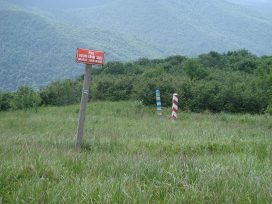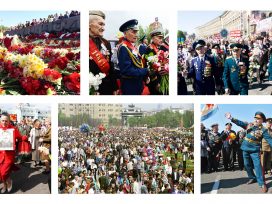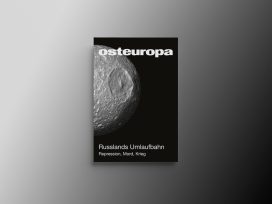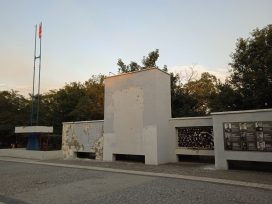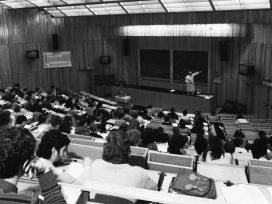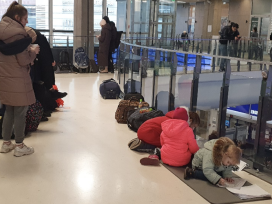On 8 May 1945, the slaughter was not yet over. In Asia, the war was still in full spate. In Europe, the Prague Offensive was underway. There were still confrontations in Yugoslavia, and the Channel Islands would not be liberated until the following day. From Moldova to Estonia, it would take Soviet forces several years to subdue anti-communist partisans.
Yet 8 May was the day when Germany’s Instrument of Surrender was signed in Berlin. The signing ceremony that had taken place the previous day in Rheims had not met with Stalin’s approval. The end of the Nazi empire should, he insisted, be signed, sealed and delivered in the presence of Marshal Zhukov, the celebrated Red Army commander.
The capitulation came into force at 23:01. This made it 9 May Moscow time. Henceforth, the victory would be celebrated in the USSR and its satellite states a day later than in the West. As for the beginning of the war, it was dated to 22 June 1941, when the Wehrmacht invaded the Soviet Union. Henceforth the USSR would usually commemorate the ‘Great Patriotic War’ of 1941–1945 and not the Second World War.
Victory Day during the Stalin and Khrushchev periods
The status of 9 May was to undergo changes, both in the USSR and in central Europe, where the holiday calendar was not uniformly aligned on the Soviet model. In Moscow and Warsaw, decrees declaring 9 May a national holiday were issued by the Communist authorities as early as 8 May 1945. In Romania, 9 May replaced Monarchy Day, previously celebrated on 10 May. As early as December 1947, however, Stalin scrapped 9 May as a work-free holiday in the USSR in favour of 1 January. (Victory over Japan Day, celebrated on 3 September, met with the same fate.) In Poland, Victory Day remained work-free until a new list of holidays was decreed in 1951. This reinstated certain religious festivals and holidays associated with Poland’s national history that had been removed from the calendar in 1946. The same year, however, Czechoslovakia did the opposite and declared 9 May to be Liberation from Fascism Day, which from now on was the country’s principal work-free national holiday.
Changes of this kind were not the exclusive preserve of the Soviet Union and its sphere of influence. In France, 8 May became a work-free holiday only in 1953, before losing that status again in a calendar reform in 1959. In 1975, Valéry Giscard d’Estaing removed it from the calendar altogether in the name of Franco-German reconciliation; and in 1981, François Mitterrand brought it back as a work-free day. In the USSR, in Poland and the other socialist republics, this change of status did not mean the end of commemorations. Victory Day was firmly anchored in the tradition of socialist state festivals, which were rigidly controlled even when combined with popular festivals.
In the satellite states, 9 May served primarily to express friendship with the Soviet Union and gratitude towards the Red Army. The latter was present not only in the form of tanks and barracks: the numerous memorials to the Red Army dead formed a background to ceremonies that were both commemorative and political, and always attended by representatives of the USSR. This geopolitical purpose was just as important inside the USSR. Victory Day salutes were fired not just in the ‘Hero Cities’ (Leningrad, Odessa, Sevastopol, Stalingrad) and sometimes the capitals of the republics, but also in Kaliningrad and Lviv, capitals of frontier regions incorporated into the Soviet Union during the Second World War. Official speeches stressed the continuity between the Soviet war effort and Stalin’s post-war international policy.
But this geopolitical dimension was combined with a pedagogical purpose, whose primary addressee was the military. Victory Day was an occasion for speeches, ceremonies and sporting events that celebrated the Soviet army, its leaders and their pre-revolutionary predecessors. All of this was aimed at young people and especially future conscripts. Central to the commemorations were a number of exemplary heroes, chosen from the millions of dead to enter the Soviet pantheon as martyrs for the Communist and patriotic cause. In this respect, Victory Day belonged to a calendar that also included other military festivals such as Soviet Army and Navy Day, Tank Drivers Day or Air Forces Day.
During the Stalin period, Victory Day was therefore not primarily a veterans’ festival, nor a day for remembering the war dead, nor a national holiday. Rather, it was an occasion for political and military propaganda. At a local level, military units or recruitment and training offices were often entrusted with organizing the programme. Particular attention was given to the periphery of the USSR, especially to western areas such as the Baltic states, Belarus and Ukraine. There, the ceremonies, exhibitions and other commemorative events were supposed to Sovietize or re-Sovietize a population that had lived through occupation, and to ensure that any memories of anti-German resistance were associated with the Red Army alone.
However, not all commemorative activities were part of the party’s propaganda programme. Outside of major memorial projects such as monuments or museums in the capital cities, the army enjoyed a certain degree of autonomy when it came to honouring its dead. In the USSR and in countries with a Soviet military presence, monuments – usually inaugurated on 9 May – were often planned and built by military engineers, and sometimes by local inhabitants, including surviving relatives, Belarusian peasants, and Holocaust survivors. Some museums and monuments would later be modified, replaced or destroyed after falling foul of the party line, though such measures were far from systematic. Christian or Jewish traditions of commemorating the dead also played a part, aided by Stalin’s comparative leniency towards religion during the war and its immediate aftermath. In addition, war veterans began to view 9 May as a day for informal reunions, self-organized lectures in schools or factories, and even guided tours of battlefield sites.
These practices did not disappear during the period of liberalization under Khrushchev, but were overshadowed by a renewed cult of the October Revolution and a future-oriented outlook galvanized by the exploits of Soviet cosmonauts and physicists. The debate about the political repressions of the previous era, despite its severe limitations, cast a shadow over Stalin, hitherto the principal symbol of the victory.
Propaganda focusing on the Soviet Union’s victory continued to play an important role abroad. This was not limited to choreographed demonstrations in the satellite states. Soviet war literature such as Aleksandr Bek’s story The Volokolamsk Highway (1943) was popular with Israeli military officers and Latin American revolutionaries. In the USSR, local commemorative practices developed especially in regions directly affected by the war. In Ukraine and Belarus, the republican governments tried to replace religious rituals with secular ones and lent their support to the cult of partisan resistance fighters.
The Brezhnev era and the cult of the Great Patriotic War
Raising the status of Victory Day was originally a Ukrainian project. In November 1964, Petro Shelest, First Secretary of the Ukrainian Communist Party, was elected to the presidium of the unionwide Communist Party’s Central Committee as a reward for supporting the removal of Nikita Khrushchev. One of his first proposals was to restore 9 May’s status as a national holiday, which would be dedicated to military parades and commemorative activities, thus separating them from the Labour Day celebrations on 1 May.
The new Soviet leadership around Leonid Brezhnev, Mikhail Suslov and Alexei Kosygin welcomed this proposal. This was firstly because they were seeking ways to remind the world – and especially the West German ‘revanchists’ – of the sacrifices made by the Soviet Union. Second, it was an opportunity to display Soviet military power at the height of the Cold War, in the face of the challenge thrown down by the non-aligned movement. When, in 1965, a 9 May military parade took place on Red Square for the first time, foreign visitors were treated as honoured guests. The day before, Brezhnev had delivered a long speech that discussed the international situation even more than the history of the war. Third, in a Soviet Union that had been shaken by a series of local uprisings triggered by social issues, the party leaders were keen to reduce pressure on the workers. Adding two new public holidays to the calendar – Victory Day and International Women’s Day – was a convenient way to achieve this. The new status of International Women’s Day as a work-free holiday was proclaimed just before the 9 May festivities and justified through reference to the contribution of Soviet women to the war effort.

Minister of Defence Rodion Malinovsky at the Victory Day parade in Moscow, 1965. Photographer unknown / from Wikimedia Commons / Mil.ru / CC BY
These changes were also part of the quest for new legitimacy. The most important political festival remained 7 November, however the October Revolution was now too distant and could no longer generate the required degree of loyalty, especially since few figures among the remaining party leaders had played any part in it. The Great Patriotic War, on the other hand, had affected every Soviet family. Twenty years on, memories were still fresh and former soldiers, many of whom now occupied key positions in society, were happy to see themselves being celebrated by the younger generation. Local forms of commemoration were taken up and homogenized into a nationwide cult of the Great Patriotic War. Victory Day became a national holiday for the Soviet people.
In the process, the cult of the Great Patriotic War was transformed. During the Stalin era, it had stressed the collective heroism of the Soviet people, especially the Russians. Now, however, commemoration began to focus more on the contribution of individual regions, towns or factories. It was also urbanized. The Soviet Union was rapidly becoming an urban consumer society, a process that was accelerated in the 1970s by the windfall from selling natural resources. Huge blocks of comparatively comfortable flats sprang up in their thousands across the suburbs, which received new war memorials and whose streets were named after war heroes.
Removed from the rural or forested areas where most of the battles had taken place, the new city-dwellers rediscovered the battlefields as tourist attractions. Victory Day became an occasion to thank war veterans for having made possible the peaceful and comfortable life that the younger generation enjoyed. Encounters with war veterans, to give them flowers and listen to their sanitized accounts, now formed part of every Soviet schoolchild’s syllabus. The ninth of May would also become the date for visiting cemeteries and commemorate the dead with the family, thus combining religious, or indeed pagan, rites with the new Soviet traditions.
Victory Day was also now part of the festive calendar. From the 1960s, the number of holidays, such as Cosmonauts’ Day or Fishermen’s Day, increased rapidly. There were also festivals that restored – in a Sovietized framework – elements of religious, popular and ethnic traditions. These included the Russian maslenitsa just before Lent (the equivalent of Shrove Tuesday or Mardi Gras), the Ukrainian vetchornytsi (parties for young people during long winter nights), or song festivals in the Baltic countries. The entertainment and carnivalesque atmosphere associated with these days began rubbing off on commemorative festivals such as Victory Day; solemn ceremonies were increasingly accompanied by popular celebrations, with new informal activities such as family photographs in front of war memorials.

Former flying ace Nikolai Skomorokhov carries the banner at the Victory Day parade in Moscow, 1985. Photographer unknown / from Wikimedia Commons / Mil.ru / CC BY
Post-Soviet commemorative conflicts
In most central European countries, commemorative activities typically moved to 8 May after the collapse of the Soviet empire. EU accession, whether achieved or aspired to, caused many countries to celebrate Europe Day on 9 May. This date was officially introduced in the European Community in 1985 to celebrate the signing of the Schuman Declaration in 1950. Only Poland continued to observe Victory Day on the 9th, along with some of the former Yugoslav republics: Montenegro, Serbia and Bosnia (where it is a day of national commemoration but only counts as a work-free holiday in the Serb part).
In the former Soviet republics, however, 9 May has retained its status as an official holiday. The only exceptions are the Baltic countries. The status of Victory Day nevertheless varies between countries. With new holidays introduced to commemorate dates in national history, Victory Day is not always a first-tier holiday. In some cases, the day has changed its name, and almost everywhere memory has become nationalized: the joint effort of the Soviet people is still mentioned, but the feats of each republic’s own heroes now take centre stage.
After the bloody constitutional crisis of October 1993, Russia was politically fractured and the authorities were searching for new sources of national unity. Labour Day and 7 November (day of the October Revolution, renamed Concord and Reconciliation Day in 1996) were too closely associated with Communist tradition; and 12 June, commemorating the declaration of sovereignty in 1990, was anathema to those who resented the end of the USSR. Victory Day was less controversial and could easily be associated with anyone’s family history, and so it came to overshadow other commemorative dates.
The opening of the huge Victory Park in Moscow and two military parades – one on Red Square and the other in the new park – on 9 May 1995 marked the rebirth of Victory Day as a major national holiday. The parades became a fixture of the annual celebrations. This trend was reinforced under Vladimir Putin: 9 May now bolstered a new-found national pride, following a decade that was widely considered to have been a humiliation for Russia. With the 2005 anniversary celebrations, Victory Day acquired even more significance, with a large and varied program of nationwide events.
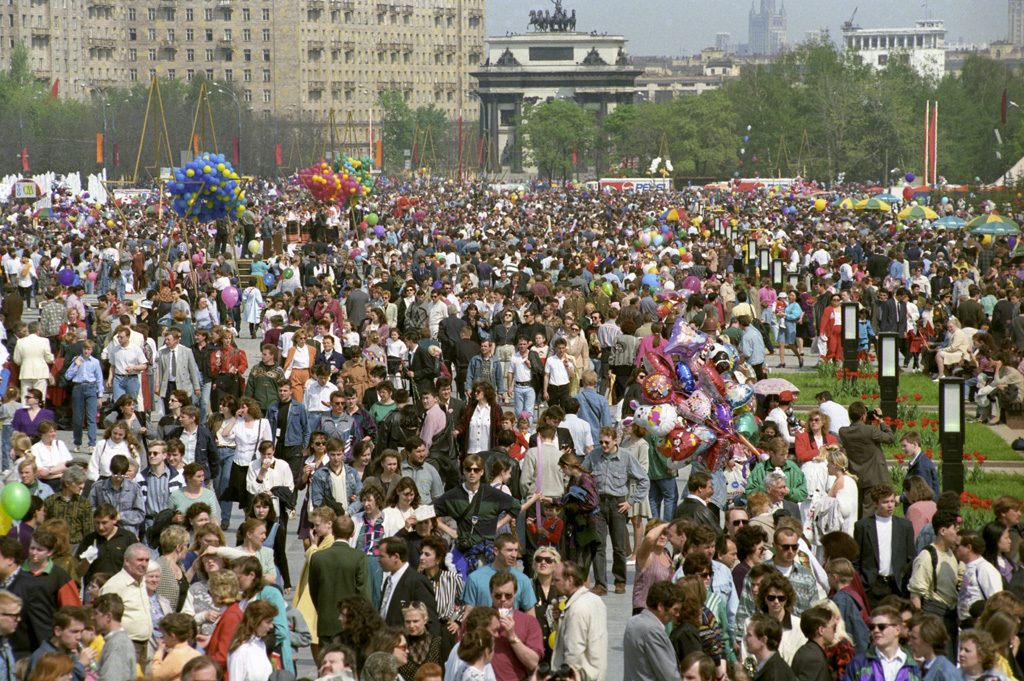
Victory Day, Moscow, 1995. Photo by Vladimir Vyatkin from Wikimedia Commons / RIA Novosti archive, image #804141 / Vladimir Vyatkin / CC-BY-SA 3.0
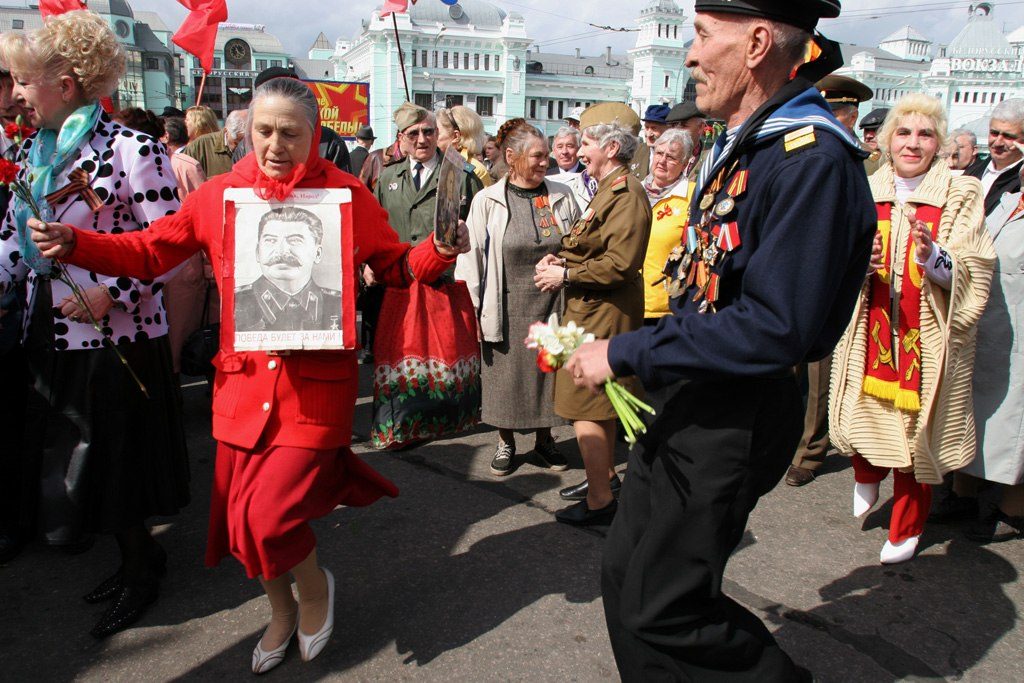
Victory Day, Moscow, 2005. Photo by Dmitry Korobeinikov from Wikimedia Commons / RIA Novosti archive, image #116731 / Dmitry Korobeinikov / CC-BY-SA 3.0
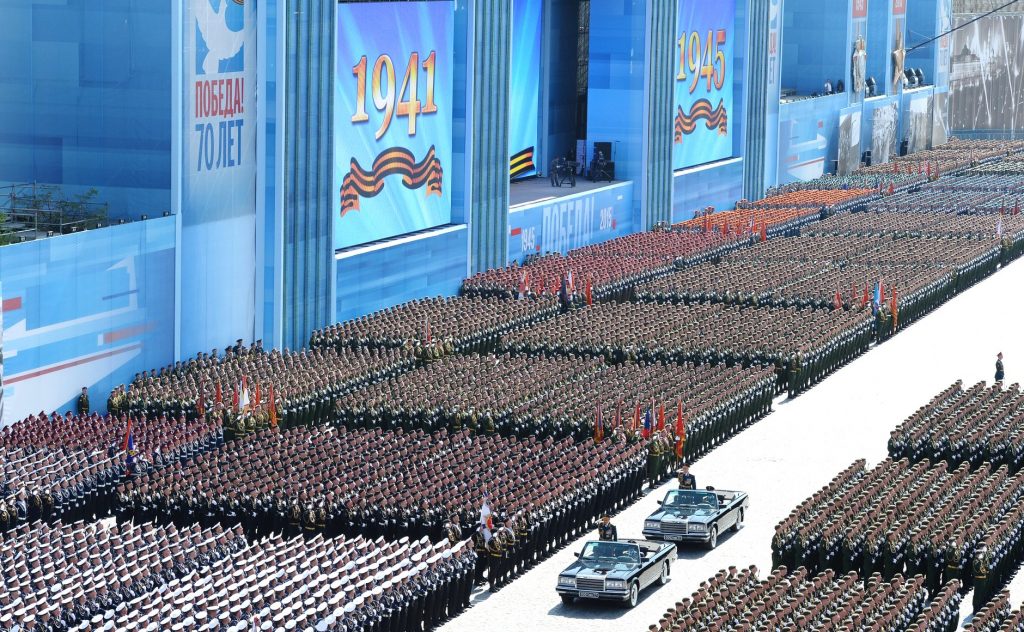
Victory Day, Moscow, 2015. Photo by may9.ru from Wikimedia Commons / Kremlin.ru / CC BY-SA
Beyond its consolidating role within Russia, commemoration of 1945 once more became a geopolitical tool. Those who questioned the traditional interpretation of the Great Patriotic War – in particular nationalist politicians and historians in central Europe – were increasingly accused by Russia of ‘falsifying history’. The presence of foreign guests at parades and other ceremonies in Moscow became an indicator of countries’ support for Russian policy. Offices responsible for commemoration were added to several Russian embassies. These are in charge of military cemeteries but also try to steer grassroots commemorative initiatives towards a pro-Moscow stance.
Indeed, numerous such initiatives have emerged since the final years of the Soviet Union. They include the poiskoviki or ‘searchers’, who unearth the remains of soldiers killed in combat. They also include historical re-enactors and participants in secular military pilgrimages, who retrace the route taken by an individual military unit by cars or on motorcycles, following routes that often end in Berlin on 9 May. Paradoxically, it was the removal of the Iron Curtain that made this kind of activity possible. Many Russian-speaking immigrants have also introduced commemorative practices rooted in Soviet traditions into their new countries, in some cases making an impact on local norms. One example is Israel, where 9 May was officially declared Victory in Europe Day in 2017.
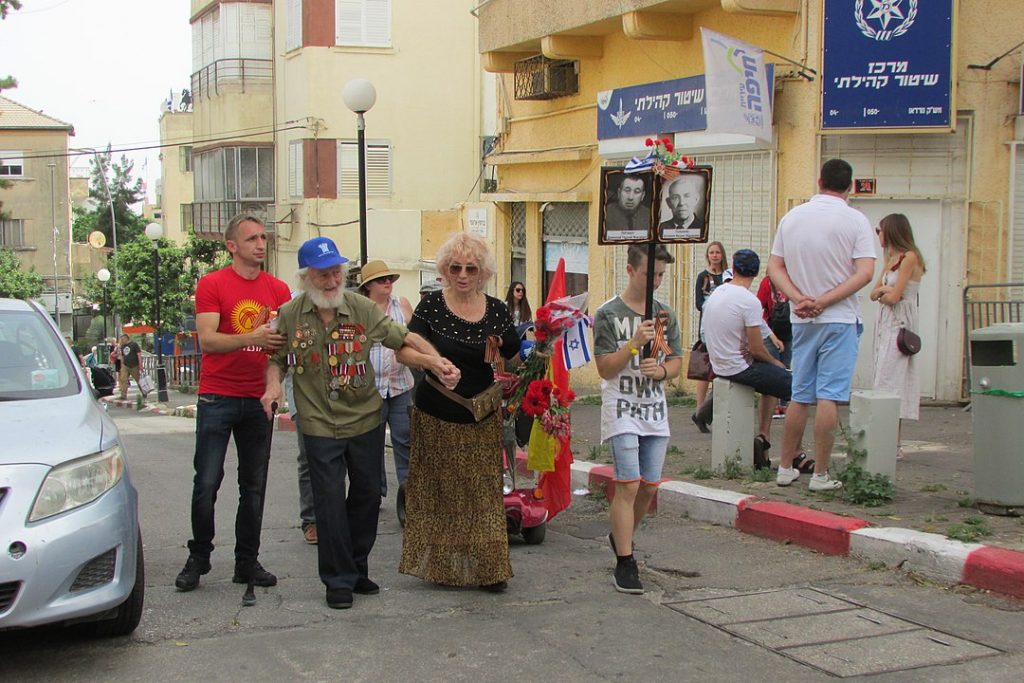
Victory in Europe Day, Haifa, 2018. Photo by יעקב from Wikimedia Commons / יעקב / CC BY-SA
There is much cross-border collaboration between such grassroots groups, and even between former Soviet republics whose relationship is beset by conflict, such as Ukraine and Russia. In Russia and Belarus, the authorities have made efforts to co-opt such initiatives, for example by incorporating the poiskoviki into state or para-state agencies. This has been successful, but only in part, since the patriotic feelings typical of such groups do not automatically translate into unconditional regime support.
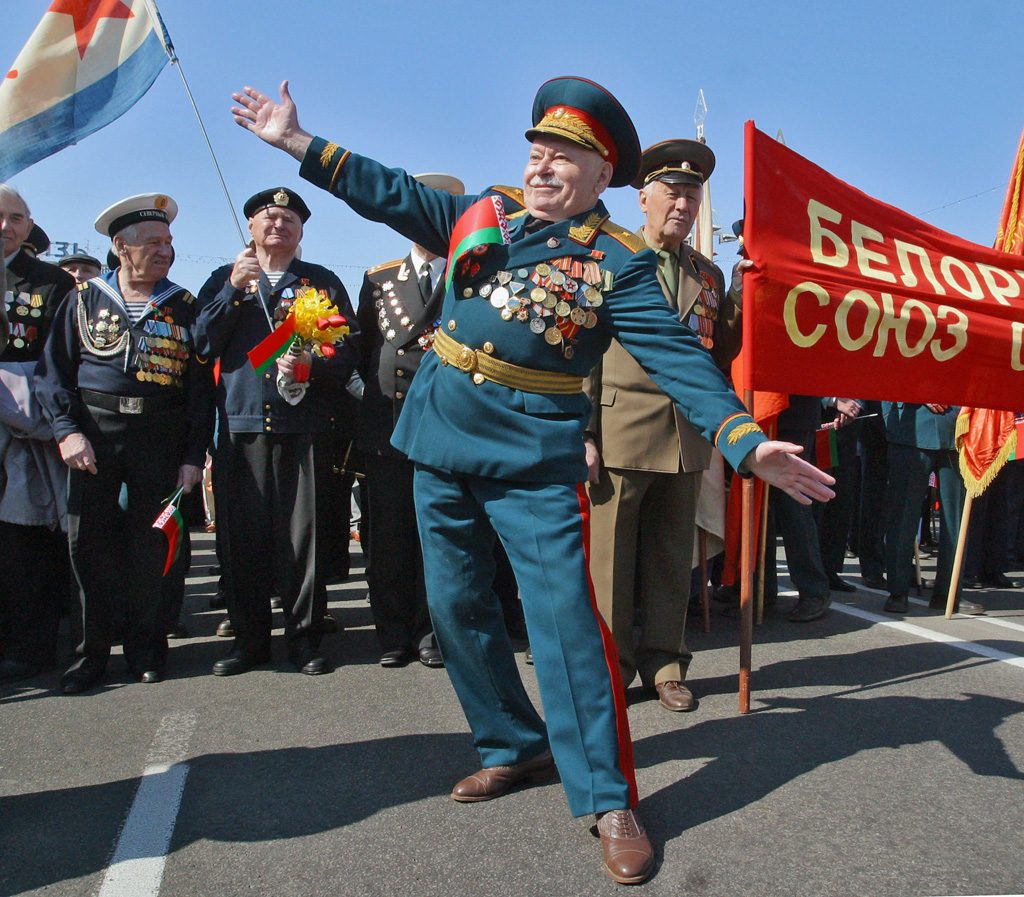
Victory Day in Minsk, 2006. Photo by Ivan Rudnev from Wikimedia Commons / RIA Novosti archive, image #127423 / Ivan Rudnev / CC-BY-SA 3.0 / CC BY-SA
In the Baltic states and Germany, participation in 9 May rituals follows its own logic. For a large proportion of the participants, they express an ethnic or political identity distinct from that of the majority. What were once compulsory practices such as commemorative processions are revived and infused with new meaning. Even though participation typically grows out of a desire for domestic recognition, Russia often presents itself as a patron of these kinds of activities. This tends to increase the mistrust already felt by local political elites, with the effect of occasionally driving local commemorative communities into Russia’s arms.

Victory Day in Riga, 2016. Photo by Kalnroze from Wikimedia Commons / Kalnroze (Wikimedia) / CC BY-SA
In post-Soviet Ukraine, new monuments and commemorative rituals serve the new public remembrance of the Holodomor (the state-engineered famine of the 1930s) or of the anti-Soviet nationalist forces of the OUN-UPA. Ukraine’s first post-Soviet president, Leonid Kravchuk, espoused a hybrid memory policy: speeches and monuments to victims of the Soviet regime coexisted with those celebrating the victory of 1945. His successor, Leonid Kuchma, at first took a similar line before aligning himself more closely with the new Russian commemorative rituals towards the end of his second term of office. After the Orange Revolution in 2004, Viktor Yushchenko, tried to turn the Holodomor into the keystone of Ukrainian remembrance culture.
Viktor Yanukovych once again reintroduced some Soviet symbols. However, all these memorial about-turns took place against a background of a certain degree of tolerance at the local level of both sides’ commemorative practices. The 9 May tradition remained largely intact for a large proportion of the population. Especially in the east of the country and in Crimea, regional political elites lent support to new initiatives, sometimes accusing their opposite numbers in western Ukraine of historical revisionism. In the west of the country, meanwhile, protests against Victory Day grew louder. On 9 May 2011, violent confrontations took place in Lviv between militants of the nationalist Svoboda party and pro-Russian activists who had turned up to support Soviet veterans.
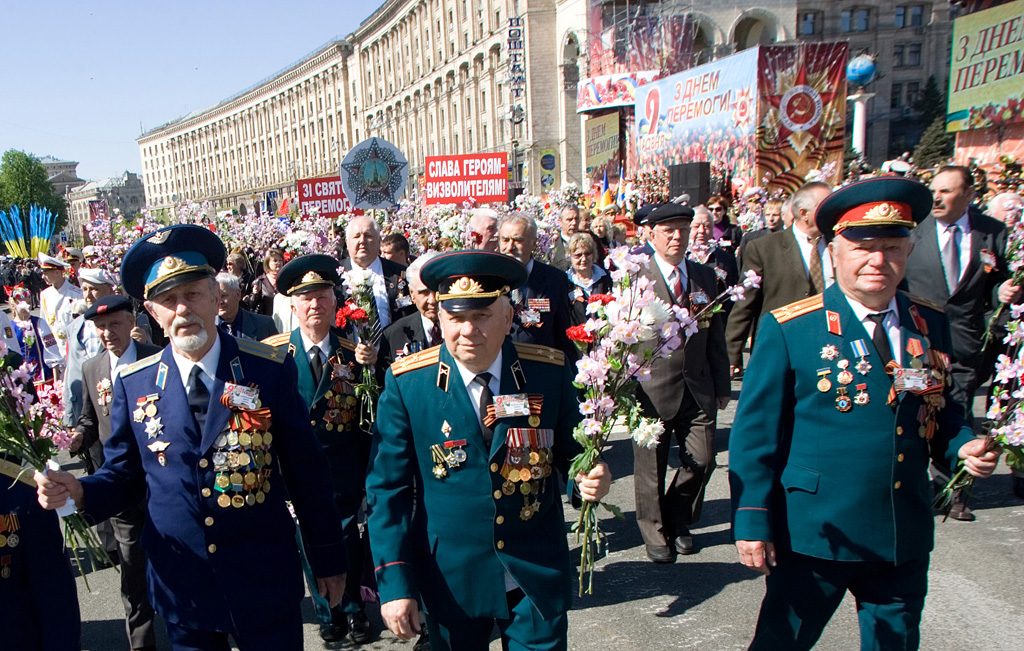
Victory Day in Kyiv, 2011. Photo by Mikhail Markiv from Wikimedia Commons / RIA Novosti archive, image #908414 / Mikhail Markiv / CC-BY-SA 3.0 / CC BY-SA
New practices, new controversies
Although the new commemorative practices have come to play a part in political and geopolitical conflicts since 1991, they are not solely the result of these conflicts. More general trends are at work in the commemoration of the war in the post-Soviet region. These include a generational dynamic and the individualization of remembrance. Two initiatives illustrate these trends and the way that they interact with today’s political reality: the Saint George’s Ribbon and the Immortal Regiment.
The black and orange Saint George’s Ribbon was introduced in 2005. It was initially proposed by a Moscow journalist employed by a state news agency, the grand-daughter of a soldier who died just before 9 May in 1995. Her inspiration for the colours came from a Russian military order of the tsarist period; these colours had already been used for ribbons of a series of Soviet badges and medals from 1942 onwards. She was also influenced by the paper poppies sold in Commonwealth countries as a means of collecting charitable donations for war veterans or other parts of the armed forces. In Russia, the idea of selling ribbons did not catch on, but they rapidly became widespread as a free and omnipresent symbol of remembrance of the war and as a means of expressing patriotism at an individual level.
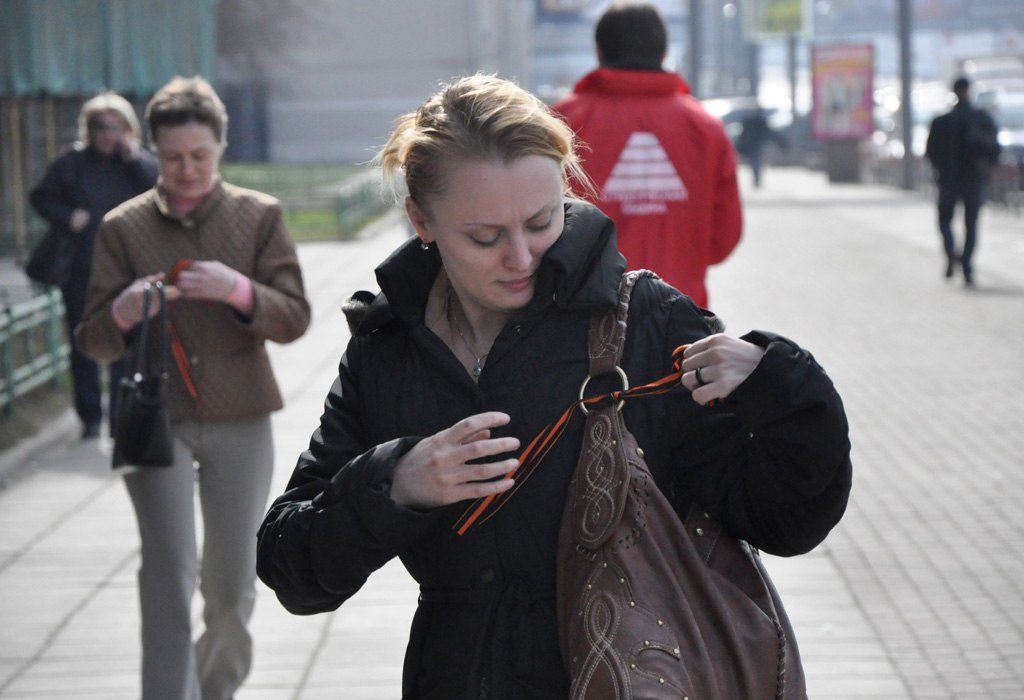
St George’s Ribbon campaign in Moscow, 2009. Photo by Olga Butenop from Wikimedia Commons / RIA Novosti archive, image #389238 / Olga Butenop / CC-BY-SA 3.0 / CC BY-SA
At first they were popularized by journalists and volunteers – in Russia and elsewhere – but were soon co-opted by the Russian state which made it essentially obligatory for officials to wear them on occasions such as 9 May and organized their distribution abroad. In the eyes of governments of neighbouring countries, this transformed the ribbon into a symbol of support for Russia’s imperialist policies (especially since 2014, given its use by Russian soldiers and separatist forces in Ukraine). Consequently, governments of neighbouring countries encouraged the wearing of alternative emblems for Victory Day: ribbons with the colours of the national flag in Belarus, Kazakhstan, Kirghizstan, Uzbekistan and, in Ukraine, the British-style poppy, in a version revised by a Kharkiv designer.
The ‘Immortal Regiment’, which dates from 2012, is another initiative launched by grandchildren of war veterans, a group of journalists working for an opposition-leaning television channel in Tomsk. Critical of what they saw as the overly state-centric traditions of Victory Day, they suggested that citizens should celebrate 9 May by marching with portraits of their grandparents or other family members who had taken part in the war, whether they had survived or not. Like the Saint George’s Ribbon, the Immortal Regiment spread rapidly throughout Russia and abroad, thanks to volunteers who were often of the same generation.
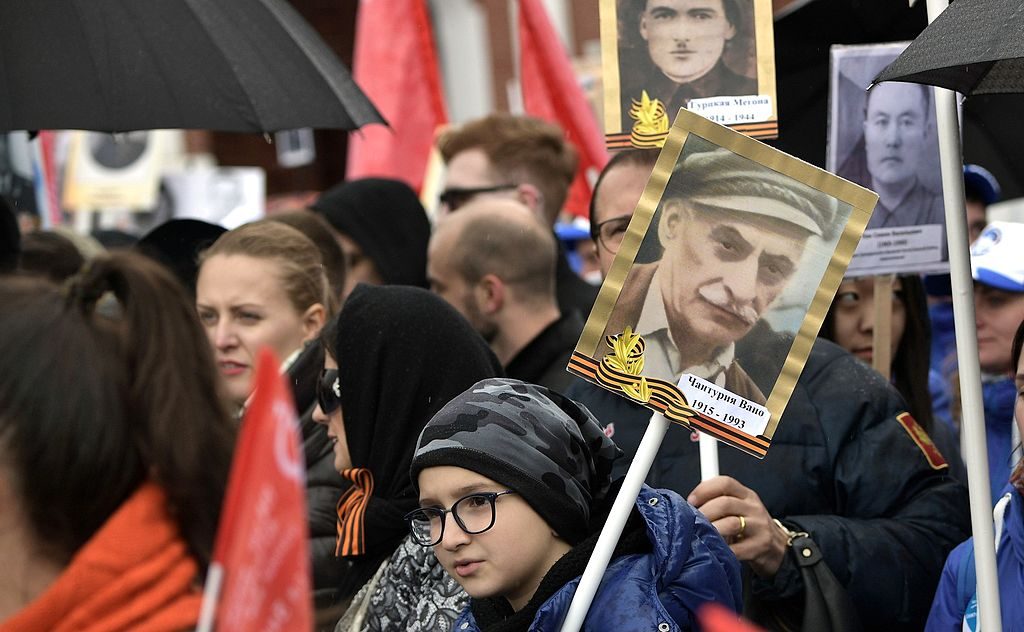
Parade of the ‘Immortal Regiment’ in Moscow, 2017. Photo by kremlin.ru from Wikimedia Commons / kremlin.ru / CC BY
Although the originators of the idea tried to ban political symbols of any kind, certain local organisers were willing to accept the support of United Russia, the party in power, which tried to incorporate the Immortal Regiment into the state’s programme of promoting patriotism. Despite the movement’s split, the initiative remains highly popular and has already had a lasting effect on commemorative repertoires. In Russia, the Immortal Regiment has contributed to a process of individualization that reinforces the status of family recollection as part of collective commemoration of the Soviet victory. Elsewhere, especially in Ukraine, the Regiment was largely discredited (along with other commemorative initiatives) because of its perceived association with the Russian state.
The annexation of Crimea, the separatist movement, and the Russian military intervention in Donbas radicalized the conflict over 9 May and remembrance. In April 2014, the Institute for National Remembrance in Kyiv proposed reforming Victory Day. Henceforth remembrance would focus on the Second World War of 1939–45 (and not the Great Patriotic War 1941–1945) and honour all Ukrainian combatants (including those of the OUN-UPA as well as soldiers of the Red Army). The Institute proposed 8 May as a new, ‘European’ Remembrance and Reconciliation Day, with the poppy as the new commemorative symbol.
A series of laws passed in 2015 introduced these changes but left 9 May as a national holiday, rechristening it as Day of the Victory over Nazism in Europe. Official Russian discourse equates the separatists’ struggle against the new Ukrainian government with the wartime antifascist struggle. However, Kyiv also refers to the Soviet commemorative tradition. For example, in one of several online video clips marking the 9 May celebration in 2015, a Soviet war veteran is getting ready to celebrate 9 May when he receives a phone call from his grandson currently fighting against Russian military intervention in the Donbas.
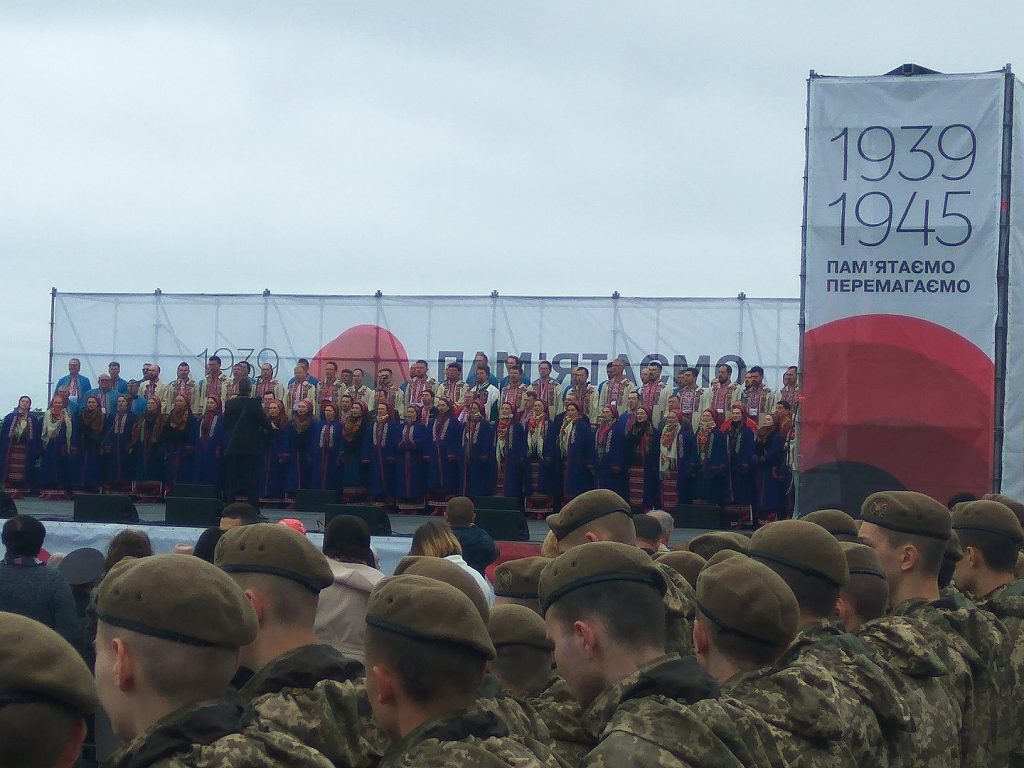
Victory Day in Kyiv, 2019 (with the poppy motif in the background). Photo by Visem from Wikimedia Commons / Visem / CC BY-SA
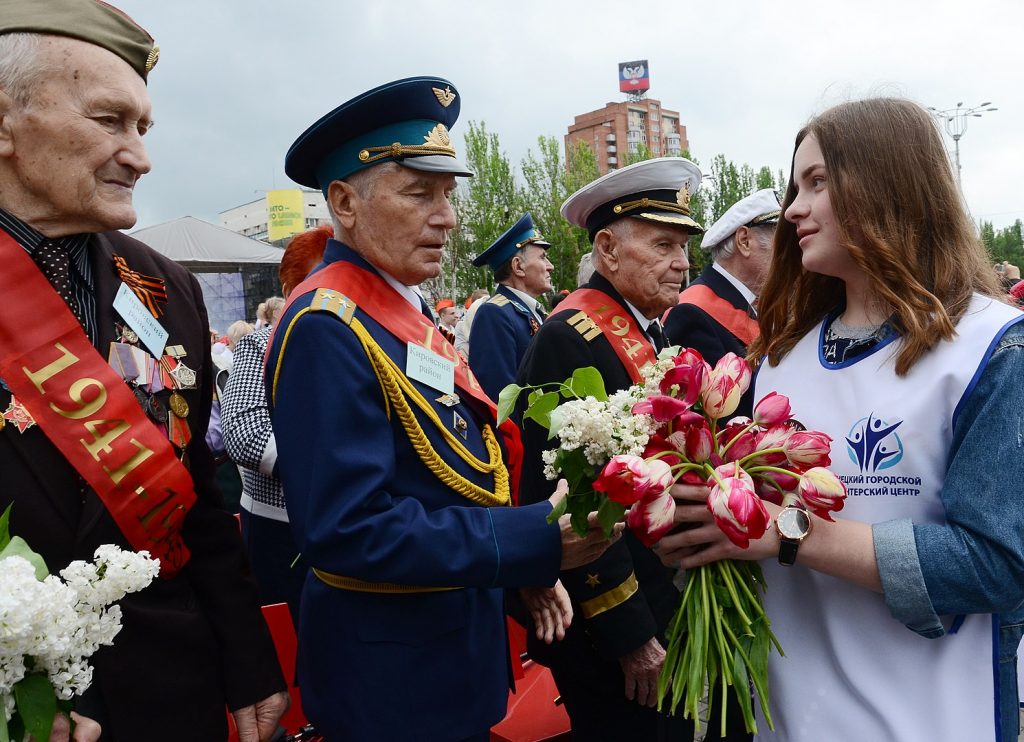
Victory Day in Donetsk 2019. Photo by Andrew Butko from Wikimedia Commons / Andrew Butko / CC BY-SA
Poland also reacted to the Ukrainian crisis. In Poland, 9 May had retained its status as a national holiday although without any official events at the highest level. In 2015, however, the Sejm passed a proposal by the Institute of National Remembrance to replace the National Victory and Liberty Festival on 9 May with a National Victory Day, henceforth to be observed on the previous day.
Beyond government-level gestures, the divergence between Russia and Ukraine is also visible at the level of social practice, even though change here has been less sudden or radical. Even though some of the new rituals and symbols are catching on in Ukraine, practices that follow the Soviet tradition have not disappeared. In several regions, violent conflicts broke out on 9 May 2017 between participants in Immortal Regiment marches and Ukrainian nationalist groups or veterans of the Anti-Terrorist Operation in the southeast.
In Russia, surveys document the increasing importance of Victory Day. Between 2010 and 2018, the number of those who named it as one of the three most important holidays went from 38% to 71%, overtaking New Year’s Day and religious festivals such as Easter or Christmas. This symbolic importance is reflected in practice: a rise in the numbers of violent deaths (often under the influence of alcohol) has been recorded for 9 May, something that does not happen on other holidays such as Russia Day (12 June) or the National Unity Day (4 November). These statistics illustrate the difference between holidays celebrated with rituals that often involve drinking, and those seen as no more than a day off work.
In Ukraine the situation is quite different. There, without exception, Christian feast days top the poll. Among secular holidays, however, 9 May retains first place, even though the number of those who say that they observe it decreased from 58% in 2010 to 37% in 2018. In 2015, just before the introduction of the new festival on 8 May, 78% of those polled in Ukraine said that the end of the war should continue to be commemorated on 9 May. Two years later, 82% still said that 9 May should be considered a highly symbolic date. International Women’s Day has also become more popular, despite attempts to abolish it because of its perceived association with Communism. At the same time, Women’s Day has not recovered the political and emancipatory significance associated with it in many western and southern countries. Both in Russia and Ukraine, it is primarily an occasion for asserting a traditional view of the role of women by presenting them with flowers.
Clearly, then, Soviet traditions cannot be discarded from one day to the next. Even so, in Ukraine, 9 May will never recover the importance it once had. Even in Russia, its significance is not something that the authorities can simply impose, since it depends to a large extent on an intergenerational dynamic.
So what does the future hold for 9 May? Outside of big anniversaries such as 2045, we are likely to see an increasingly specialized commemoration organized by historical re-enactment groups, searchers or amateur historians, similar to commemorations of more distant wars. At the same time, the association of 9 May with Russia might potentially transform it into an ethnic festival for Russian-speaking communities outside the country. It might even lose its political connotations. This is what has happened with the Cinco de Mayo which, in Mexico, commemorated the victory of Republican forces over a French expeditionary army, but in the US has been transformed into a generic festival of Hispanic culture.
In the worst-case scenario, 9 May might suffer the same fate as the Sedantag, the biggest national holiday in imperial Germany between 1871 and 1918, celebrating victory in the Franco-Prussian War. It was effectively rendered obsolete by the collapse of the Reich following Germany’s defeat in a new war, and swiftly forgotten.
The original French version of this article will appear as a chapter in Korine Amacher, Eric Aunoble, Andrii Portnov (eds), Histoire partagée, mémoires divisées. Ukraine, Russie, Pologne. Lausanne, Editions Antipodes (forthcoming), and has been published online on politika.io
